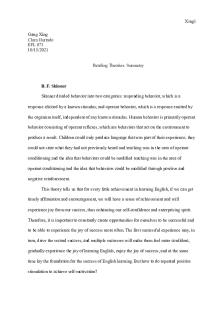Theories of aeging - Summary Sociology PDF

| Title | Theories of aeging - Summary Sociology |
|---|---|
| Course | Sociology |
| Institution | University of Portsmouth |
| Pages | 2 |
| File Size | 37.4 KB |
| File Type | |
| Total Downloads | 43 |
| Total Views | 164 |
Summary
Summary of the theories of ageing that affects and shapes society. These theories include the disengagement theory and the active theory....
Description
The two theories of ageing: The disengagement theory is a theory that the elderly disengage and separate from active roles in society. It was created by Cumming and Henry in the 1960’s. It is expected when an individual gets older that they exclude themselves from any involvement in society because they are retired. Because of old age they do not interact with others and their physical health forces them to withdrawal from social activities.The withdrawal is a natural process and it is acceptable. This highlights that gradual withdrawal from society and relationships helps to promote self-reflection and self-identity, especially for elders who are retired and freed from their socially active jobs.As a result, they reduce their communication with friends and family. Which is considered normal and appropriate because it benefits both society and the elderly. The disengagement theory benefits the elderly because they receive the freedom to do what they want and less stress is developed. The stress that they went through during their life to provide money for their family is reduced because they receive pension and support from advocates and charities. The theory benefits the society because more jobs will become available for the young and working generation, especially the unemployed. It allows the transfer of knowledge, control and power from the older generation to the young. This highlights it’s possible for society to continue to grow and function after a valuable individual has died or withdrawn from society. So it’s very important for the elderly to separate from society to maintain the social system. There are changes that are likely to be seen in ageing individuals that can support this theory. The disengagement theory states that there are issues an individual ages and it limits their social interactions. For example, there are problems such as poor health and poor mobility because the, muscles have weakened. Arthritis may occur and it can stop the ageing individuals to take part in social and physical activities, like swimming and walking with family and friends because it’s too painful to move around and interact. Their doctor would recommend the individual to be less mobile to reduce any significant pain. This supports the theory because it limits any physical activity resulting in less social interactions that would engage them with society. Due to the lack of these physical and social activities it could lead to loneliness and depression. In addition, the disengagement theory can happen through a series of events such as bereavement. For the individual to cope with bereavement and isolation they could develop bad habits such as smoking and drinking. Which would increase a lack of self care and a poor diet affecting their health. However, it can be suggested that elderly people who become detached from society are already reclusive individuals. These are individuals who avoid the company of other people and as a result seclude themselves from social activities. In addition many elderly people want to remain busy and involved with society. The active theory was developed by Robert Havighurst in 1961. The active theory states that many elderly people retire from work and give up their roles in society. These changes question their self-identity and their purpose after retirement. So this theory was created to go against the disengagement theory. It’s important for elderly people to engage in activities that helps them to develop a replacement for the roles they have abandoned due to their retirement or redundancy. This highlights that activities are essential to restore one’s confidence and increase one’s value of well-being. This theory claims that the more mentally and physically active elderly people are, they are more likely to be satisfied with their life. It
proposes that successful aging can only occur when older adults maintain social interactions and personal relationships....
Similar Free PDFs

Theories of sociology essay
- 4 Pages

Summary of nursing theories
- 19 Pages

Theories of Personality Summary
- 43 Pages
![[ Summary] Theories OF Personality](https://pdfedu.com/img/crop/172x258/1056yokdyg92.jpg)
[ Summary] Theories OF Personality
- 90 Pages
![[ Summary] Theories OF Personality](https://pdfedu.com/img/crop/172x258/nq5oe6wpwzlx.jpg)
[ Summary] Theories OF Personality
- 89 Pages

Human Growth Summary of Theories
- 3 Pages

Reading Theories Summary
- 4 Pages

Sociology Chapter 1 Summary
- 2 Pages
Popular Institutions
- Tinajero National High School - Annex
- Politeknik Caltex Riau
- Yokohama City University
- SGT University
- University of Al-Qadisiyah
- Divine Word College of Vigan
- Techniek College Rotterdam
- Universidade de Santiago
- Universiti Teknologi MARA Cawangan Johor Kampus Pasir Gudang
- Poltekkes Kemenkes Yogyakarta
- Baguio City National High School
- Colegio san marcos
- preparatoria uno
- Centro de Bachillerato Tecnológico Industrial y de Servicios No. 107
- Dalian Maritime University
- Quang Trung Secondary School
- Colegio Tecnológico en Informática
- Corporación Regional de Educación Superior
- Grupo CEDVA
- Dar Al Uloom University
- Centro de Estudios Preuniversitarios de la Universidad Nacional de Ingeniería
- 上智大学
- Aakash International School, Nuna Majara
- San Felipe Neri Catholic School
- Kang Chiao International School - New Taipei City
- Misamis Occidental National High School
- Institución Educativa Escuela Normal Juan Ladrilleros
- Kolehiyo ng Pantukan
- Batanes State College
- Instituto Continental
- Sekolah Menengah Kejuruan Kesehatan Kaltara (Tarakan)
- Colegio de La Inmaculada Concepcion - Cebu







